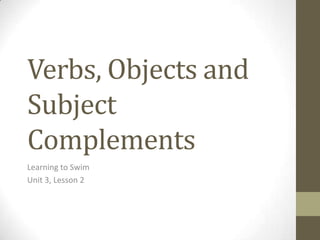Verbs, objects and subject complements
•Télécharger en tant que PPTX, PDF•
3 j'aime•3,591 vues
Class presentation
Signaler
Partager
Signaler
Partager

Recommandé
Contenu connexe
Tendances
Tendances (20)
En vedette
En vedette (11)
Detailed Lesson Plan (ENGLISH, MATH, SCIENCE, FILIPINO)

Detailed Lesson Plan (ENGLISH, MATH, SCIENCE, FILIPINO)
Simple, Compound, Complex, Compound Complex Sentences

Simple, Compound, Complex, Compound Complex Sentences
Similaire à Verbs, objects and subject complements
Similaire à Verbs, objects and subject complements (12)
Copy of English Language Grammar Rules _ by Slidesgo.pptx

Copy of English Language Grammar Rules _ by Slidesgo.pptx
Plus de Finytorres
Plus de Finytorres (13)
Verbs, objects and subject complements
- 1. Verbs, Objects and Subject Complements Learning to Swim Unit 3, Lesson 2
- 2. Direct Objects • A direct object follows an action verb and answers the question “Whom?” or “What?” It is always a noun or a pronoun. Not all action verbs require direct objects. • Joe likes apples and corn. The direct objects “apples” and “corn” answer “Joe likes what?” • The boy in the red coat bought a new kite. “Kite” answers “ • The boy bought what?” • Henry waited on the corner. There is no direct object following the action verb “waited.”
- 3. Indirect Object • An indirect object comes between the action verb and the direct object and answers the question “To whom?” or “For whom?” It is always a noun or pronoun and never appears by itself without a direct object. • The boy in the red coat bought his brother a new kite. • The indirect object “brother” answers “The boy bought a new kite for whom?” “Brother” comes between the action verb “bought” and the direct object “kite.”
- 4. Subject Complements • A subject complement follows a linking verb (is, are, was, were, am, be, seems, feels, etc.) and renames or describes the subject of the sentence. Subject complements may be nouns, pronouns, or adjectives. • Joe is a vegetarian. The subject complement “vegetarian” follows the linking verb “is” and renames the subject “Joe.” • The boy’s new kite was blue. The subject complement “blue” follows the linking verb “was” and describes the subject “kite.”